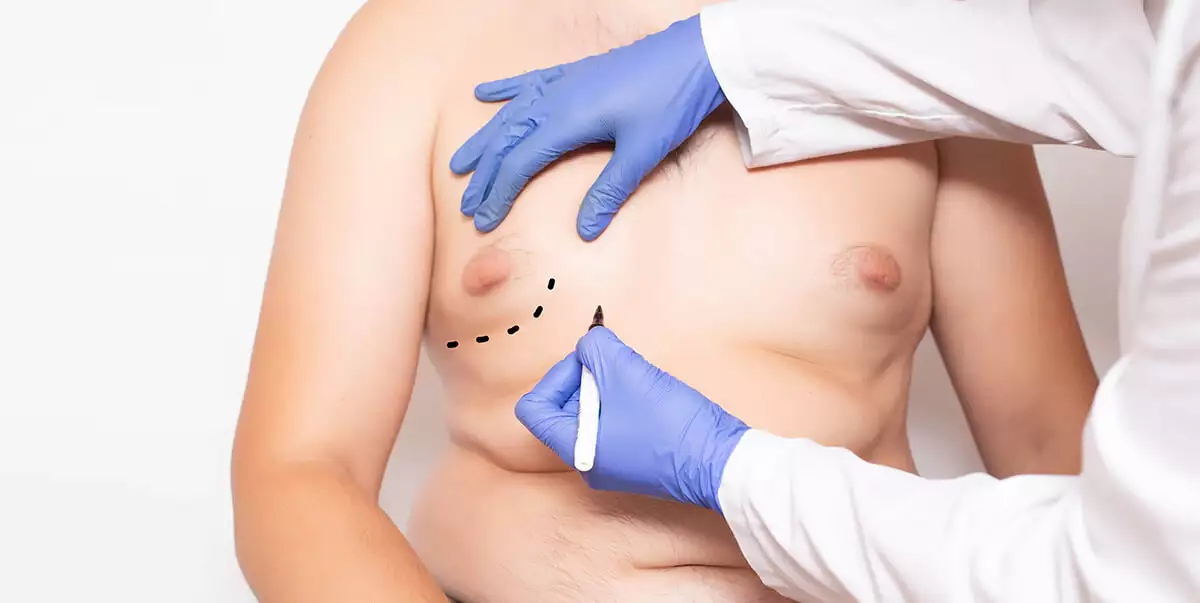
Gynecomastia
What is Gynecomastia surgery?
Gynecomastia, also spelled as Gynaecomastia and referred to as male breast reduction, is the abnormal development of breast tissue in men due to an imbalance between the estrogen and testosterone hormones. Obesity, the growth of breast tissue due to the increase in adipose tissue throughout the body is called pseudo-gynecomastia. Gynecomastia can go away on its own, but if not, Gynecomastia surgery is the best option to remove the excess breast tissue.
Why is Gynecomastia surgery performed?
Gynecomastia can develop at any age, but is more frequent with children going through puberty and men older than 50. The physical appearance caused by Gynecomastia is commonly called man boobs. The enlarged breasts can be stressful and embarrassing for many men. Gynecomastia is the most common male breast disorder and affects 50% to 65% of men. Gynecomastia surgery completely removes the excess breast tissue and gives an appealing physical appearance to the breasts.
What are the conditions for Gynecomastia surgery?
Gynecomastia Surgery is recommended to male patients who:
- Are healthy enough to undergo general anesthesia.
- Have excessive breast tissue.
- Are above the age of 18 or above the age of 15 with parental consent and the doctor’s recommendation.
- Preferably have Body Mass Index, BMI, of lower than 30.
What Are The Things To Be Considered Before Gynecomastia surgery?
Before the surgery, the patient should:
- Be at the hospital a day before their surgery for the pre operative tests to be performed.
- Stop smoking and consuming alcohol at least 2 weeks before the surgery to alleviate the risk of a blood clot.
- Avoid medication containing aspirin or ibuprofen (Advil, Motrin IB, others) for two weeks before and after surgery. These medications may increase the risk of internal bleeding. Patients should confirm each medication and supplement they wish to take with their Patient Coordinator.
- Stop taking Multivitamin supplements 7 days prior to the surgery, and if it contains vitamin K should not be used for 30 days following the surgery.
- Stop taking oral contraceptives 30 days before the surgery.
Also, the patient's body will be examined and measured, and the surgeon will draw lines on the body to plan out where the incisions will be made.
How is Gynecomastia surgery performed?
Gynecomastia surgery starts with general anesthesia being administered.
The surgery can either include removal of fat, beast tissue, or both. Incisions are made around the breasts. If fat removal is being performed, liposuction is performed through the incision. If breast tissue is to be removed, the surgeon removes the tissue through the incision as well and then reshapes the breasts. After tissue removal, the nipples may be adjusted to make them appear more appealing. The incisions are then sealed with sutures.
If only Liposuction is administered the surgery takes an average of 1 hour. Otherwise the surgery may take 2 to 4 hours depending on the size of the breasts, the condition of the excess skin and the surgical technique to be applied.
What Are The Things To Be Considered After Gynecomastia surgery?
After the surgery the chest will be supported with bandages and plasters, if any tubular drains are placed, they’ll be removed 48 hours after the surgery. the patient should take care to:
- Wear a Gynecomastia corset for 4 to 6 weeks, which will apply pressure to the breast and will be provided for after surgery.
- Avoid strenuous physical activities like heavy workouts for 6 weeks after surgery.
- Have a healthy diet as it will make the healing process faster.
- Take their prescribed medication as instructed by their doctor.
- Avoid lying face down as it will put pressure on the chest.
Patients can return to work 5 to 7 days after the operation. In proportion to the decrease in breast size, the diameter of the nipple also decreases and its color takes on a darker tone
What Are The Risks of Gynecomastia surgery?
As with any surgical procedure, there are risks involved with Gynecomastia surgery. These include, but are not limited to
- Fluid accumulation near the skin, Seroma
- Blood clots
- Bleeding
- Infection
- Swelling
- Poor wound healing
- Scarring
- Changes in skin sensation
- Adverse reaction to anesthesia
All breast reduction procedures leave breast reduction scars. They will fade over time. But they never go away completely.
